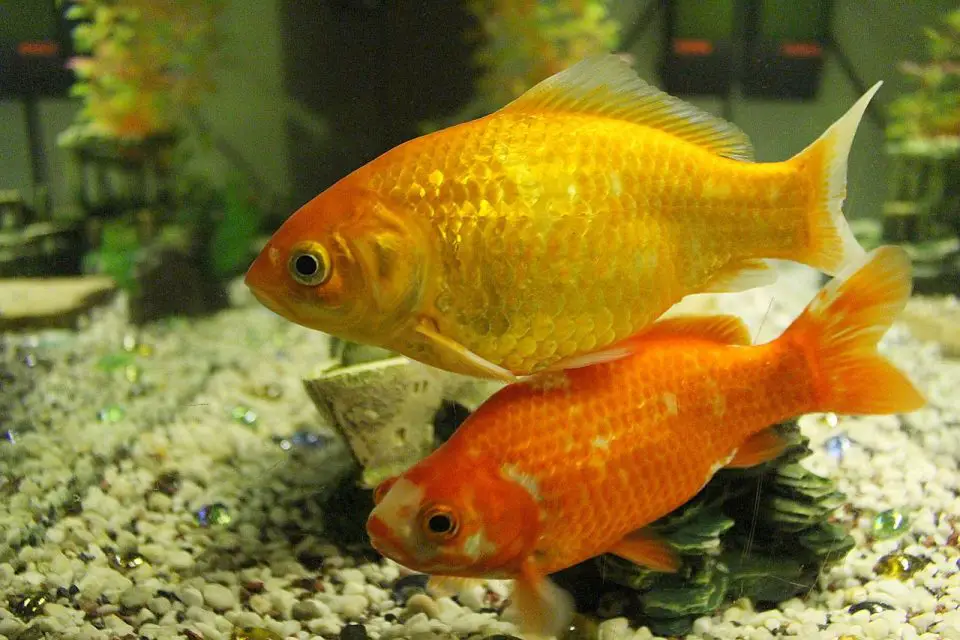Fish are one of those animals that everyone knows of but very few people truly know about.
For instance, did you know that a certain species of fish, known as the lungfish can survive out of water for many years? This is because they have both gills and lungs.
Or look at a betta fish. Betta fish have an organ known as a labyrinth organ which allows them to surface the water and breathe air – a behavior you may see them doing often.
The labyrinth organ also allows them to live outside of water like a lungfish for a short period of time, so long as they stay moist.
It’s facts like this that lead you to really wonder about fish anatomy, such as if they have tongues or not.
Now, you may have heard of a food called fried cod tongue, but think, have you ever actually seen a fish’s tongue?
You see their gills and their eyes, and you may have even seen their teeth, but you might not have ever seen their tongue.
So, do fish have tongues? Well, the answer’s a bit more complicated than a simple yes or no.
You see, there are many species of fish that do have tongues, but even then, they aren’t the same as your tongue.
In fact, fish tongues don’t really resemble tongues at all. Think about your own tongue.
Mammals have a strong, muscular tongue that is designed to be used for a variety of tasks such as tasting, swallowing, and even chewing – the latter especially in babies.
On the other hand, a fish’s tongue is bony and fused to the floor of the mouth. Rather than being used for eating, it’s a protective structure designed to keep the ventral aorta safe.
There are tongue variations among even different species of fish however. Not all fish have tongues. Some fish tongues have teeth that help them swallow small prey.
One species of bony fish is ‘Glossandodan’, which literally means ‘tongue teeth’. Some can even lose their tongues to certain parasites. Are you hooked yet? If so, keep reading!
Here’s everything you could ever want to know about fish tongues.
Fish Tongue Anatomy
First, a fish tongue isn’t actually called a tongue.
Its scientific name is basihyal, which can be broken down into basi-, which means base, and -hyal, which shows that it is referring to the hyoid bone situated in the neck.
Thus, the basihyal is a bony structure that is found on the floor of the mouth, connecting towards the back of the mouth just like a human tongue.
It resembles a tongue, so, if you have managed to see one before, you might have thought that it was identical to a human tongue in function.
However, the basihyal isn’t a muscle, and it doesn’t have taste buds – though, we’ll talk more about taste buds next.
The basihyal, rather than directly aiding in ingestion, acts more like a ribcage for the mouth.
In fish, the ventral aorta – this is the artery that carries deoxygenated blood from the heart to the gills so that it can receive oxygen – is located close to the mouth.
Thus, the basihyal is theorized to have developed as a way to protect this valuable artery.
Fish tongues also lack mobility – for the most part. Since their tongues aren’t muscular, they lack the ability to move.
However, this isn’t true for all fish. Take the lamprey – an ancient species of jawless fish – for example.
Lampreys, due to the anatomy of their jaw and the suction function of their mouth, they have the ability to protrude their tongue out of their mouth.
Now since you know more about the anatomy of fish tongues, you may be wondering about other parts of oral anatomy, such as taste buds and teeth.
Taste Buds
 Before talking about fish, though, it’s important to understand how your own taste buds work.
Before talking about fish, though, it’s important to understand how your own taste buds work.
You see, a lot of people think that you have taste buds on your tongue, but this isn’t necessarily true.
While you do have taste buds on your tongue – a quick sip of a too hot drink will prove that fast enough.
You also have them in other places such as your soft palate, upper esophagus, cheek, and epiglottis – which is a fleshy membrane that folds over your larynx when drinking and eating to protect your respiratory tract.
Fish are similar in a way. While they do have taste buds, they don’t occur on their tongues.
Taste buds have to be moist, and, since fish live in water, they can have taste buds on the exterior of their bodies as well.
Fish taste buds form on the inside of their mouths, the outside of their lips, and certain species, like catfish, have as many as 100,000 taste buds across the entirety of its body as well as on its barbels.
To give you an idea of how many that is, humans only have a maximum of 8,000!
So, you may be wondering why fish have taste buds outside their body. Sure, they live and water so it’s okay for them to, but why?
Well, that’s because, for fish, taste buds are for more than just tasting food – it helps them find food.
By being able to taste the water around them, fish, along with their acute sense of smell, can judge if there are any prey or predators nearby.
Do Fish Have Teeth Elsewhere?
Earlier, I mentioned that some fish have teeth on their tongue to aid them in swallowing small prey.
They have teeth in other places too! You can find fish teeth lining their upper and lower jaws, mouths, lips, and throat, which are called pharyngeal teeth after the pharynx.
Different species of fish have different types of teeth that correspond with their environments and diets.
Carnivorous fish, for example, will have sharp teeth for tearing and ripping, while herbivorous teeth will have flat, strong teeth for grinding plant matter.
What are Cod Tongues Then?
So, I mentioned earlier that you might have eaten fried cod tongue before. Fried cod tongues are a regional delicacy in Newfoundland and Labrador.
Cod has a deep history in Newfoundland, and, before the moratorium of 1992, cod was a lifestyle.
Families of fishers would dedicate their hours to fishing, and it was common for the children to harvest cod tongues to either keep for themselves and their families or to sell for pennies on the streets.
Now, though, you can find them costing as much as $10 a pound.
But, if fish don’t have muscular and fleshy tongues, what exactly are cod tongues?
Well, they aren’t the basihypal that we discussed earlier, so they technically aren’t actual tongues, even by fish standards.
Cod tongues are actually a small Y-shaped strip of flesh that is taken from either the jaw or throat of the cod.
It’s thick and fleshy, with an almost gelatinous texture. It’s often served fried, but that’s not the only way to cook it.
Differences Between a Fish Tongue and Mammal Tongue
You may have already noticed a big difference in fish tongues, basihyals, and mammal tongues.
To review, fish tongues are boney instead of muscular, don’t have taste buds but may be lined with teeth, and are designed to protect the ventral aorta rather than aid in ingestion and consumption.
The differences don’t stop there, however!
Mammal tongues allow them to suck. This can be observed in infancy with newborns suckling or in adults with straws. Fish tongues do not allow them to suck.
They do, however, give fish the ability to transport food quickly from the front of the mouth into the throat, especially if their tongues are lined with teeth like the pirarucu.
Mammal tongues are an important organ that aids in chewing and swallowing. Fish tongues are just as important, if not more so, but in a different way.
Fish tongues help with the movement of oxygenated water through the gills, which then provides oxygen to the ventral aorta, which then helps spread oxygen to every part of the fish’s body.
What Species of Fish Have Tongues?
There’s a surprisingly large amount of fish that have tongues. In fact, you may have one of the most common fish with tongues swimming in an aquarium in your house right now.
That’s right, goldfish! During feedings, if you ever can get close enough and get the right angle, you may just notice your goldfish’s tongue.
While not considered a fish, you’ll also find that some species of sharks have a basihyal tongue as well!
Fish Tongues and Parasites
If you ever catch a fish, you may notice that, yes they have a basihyal tongue, but they also have a not so pleasant surprise!
Fish tongue parasites are surprisingly common, with the most frequent invader being a parasitic isopod known as the Cymothoa exigua, or, their common name, the tongue eating louse. Not a nice name, is it?
The tongue eating louse has a very interesting way of invading a fish’s mouth.
Female louses will enter the fish’s mouth through their gills, and then, using their sharp front claws, they will sever the blood vessels that attach to the tongue.
Without a blood supply, which provides nutrients and oxygen to the cells in the tongue, the tongue will atrophy away.
Then, the louse is able to attach itself to the muscles as the stub of the tongue.
After this initial amputation and modification, the louse doesn’t cause much more damage to its host fish’s body, satisfying itself with consuming either the fish’s mucous, blood, or even fragments of their prey during ingestion.
When the host fish dies, the louse will detach itself from the stub of the tongue and will leave the host’s body.
Final Thoughts: Do Fish Have Tongues?
 Fish anatomy can be a really interesting topic, just because how their bodies are designed and organized and even function can be so vastly different from us.
Fish anatomy can be a really interesting topic, just because how their bodies are designed and organized and even function can be so vastly different from us.
It’s amazing to see how something as simple as their tongues can be so different from our tongues.
Understanding the anatomy of your fish can help you understand why and how they do the things they do, such as eat or breath.
It can also help you understand how, in the wild, fish interact with their environments and protect themselves.
There are a lot of differences between a mammal’s tongue – like your own – and a fish’s tongue, known as a basihyal.
However, both are just as important. Fish tongues, for instance, while not being used in the consummation of food other than moving it along the mouth, do a lot of other important things.
Fish tongues help fish breath by assisting the gills with drawing in oxygenated water, and, due to their boney structure, they help protect the vital ventral aorta which resides close the fish’s mouth and brings deoxygenated blood from the heart to the gills to pick up oxygen from the water.
Understanding the anatomy of a fish’s tongue can also help you understand parasites better.
The most common fish tongue parasite, known commonly as the tongue eating louse, causes the fish’s tongue to die and then replaces it.
This means that, if you didn’t know that a fish doesn’t actually use its tongue when it is eating food, you might wonder how the fish was able to eat.
It can also be helpful to understand the anatomy that fish’s tongues don’t have – take taste buds for example.
Once you learn that fish have taste buds all over their body and not their tongue, it allows you to see just how useful they are when your fish is trying to interact with their environment.
You can also experiment with this by changing where you place your fish’s food and watch them try to find it in the water using their senses of taste and smell.
Learning about fish, while a little strange at first, can be a fun experience that changes just how you look at your little finned friends.
